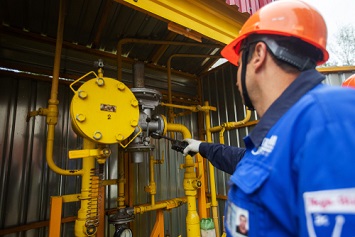Are your workers and business protected against the potential dangers of hydrogen sulfide (H2S) exposure? It may surprise you that subjection to the toxic “sour” gas remains one of the leading causes of workplace gas inhalation deaths, and OSHA recently cited a Texas employer after H2S exposure in a confined space resulted in a fatality. There are several ongoing misperceptions about the hazards the gas presents and how best to protect against them.
Here, we shed light on the perils of H2S in the oil and gas industry and debunk common myths about updated H2S training standards designed to better protect workers and guard employers and contractors against hefty fines. Better understanding standards and leveraging training best practices can help to create more effective H2S training programs that comply with current guidelines and save lives.
Understanding H2S in the Petroleum Industry
Protection against overexposure to H2S, a highly toxic and explosive gas, starts with understanding the chemical and the inherent risks it carries, specifically to the petroleum industry (although it is not the only industry susceptible to the danger).
The colorless gas—known as a sour gas—is naturally produced by the decomposition of organic materials, including oil and gas deposits. It is also emitted as a by-product of many industrial processes, including the desulfurization process involved in petroleum production and refining.
The primary method of exposure to H2S is through inhalation, whereby the gas is rapidly absorbed by the lungs. People can only smell its “rotten egg” odor when lower concentrations of the gas exist. However, after continuous low-level exposure, or with higher concentrations, a person loses the ability to smell the gas. This can happen very quickly, and at high concentrations, the ability to smell the gas can be lost instantaneously, making it fatal in as little as one breath.
H2S is a major hazard to workers in the oil and gas industry. During drilling operations, H2S may be released at the shale shaker area and the circulation fluid treatment areas, during tripping procedures, at the wellhead, in the cellar, and onto the drilling floor. Those who work in confined spaces where the chemical can build up to dangerous levels or in low-lying areas like trenches, where pockets of H2S can form and have little avenue for escape, are especially vulnerable.
Because the gas is present in some subsurface formations, drilling and other operational crews must be properly trained and prepared to use proper detection and personal protective equipment (PPE) when working in H2S-prone areas. H2S enters drilling mud from subsurface formations and can also be produced by sulfate-reducing bacteria in stored muds. The presence of H2S can also lead to sulfide stress corrosion cracking of metals, which can significantly compromise the integrity of underground tubing and casing, leading to additional safety and costly equipment issues.
Several federal government agencies, including the Occupational Safety and Health Administration (OSHA), regulate and enforce H2S exposure limits to protect companies and workers. The American National Standards Institute (ANSI) provides specific practices and standards to mitigate hazards of H2S. The oil and gas industry leverages protocol and equipment to identify and control H2S presence and relies on effective training programs to educate workers to recognize the dangers and instruct them on proper procedures, precautions, and the use of PPE, such as respiratory protection, eye protection, and possibly fire-resistant clothing, to guard against incidents. Lack of or insufficient training can lead to accidents or fatalities, resulting in citations and costly fines to operators and contractors that fail to ensure proper safety.
The ANSI Z390.1-2017 Standard Increases and Better Defines Safety Training for Workers in H2S Areas
In 2017, as a response to growing awareness of the danger presented by H2S and the need for tighter safety measures, ANSI and the American Society of Safety Professionals (ASSP) released an updated standard—ANSI/ASSP Z-390.1-2017—related to training programs for those working in areas where H2S is present or potentially present. The updated standards address affected personnel, training delivery methods, and frequency to guide operators to provide more effective worker training. The standard also helps trainers deliver refresher training to keep workers up to date on important information and best practices related to H2S safety.
Although OSHA officials hold organizations to regulations, many companies are unaware of the changes or believe that their current training program meets the updated standard, opening them up to the potential for incidents and fines. Among the most costly contractor fines for improper H2S training was that against RKM Utility Services, which was fined more than $400,000 in 2018 for failing to protect employees working in areas with known H2S dangers.
Dispelling Common Misperceptions to Better Protect Against H2S Dangers
Clarifying updated training standards that are often misunderstood helps operators comply with current ANSI standards, enabling them to build more effective training programs that guard against incidents and align with OSHA requirements. Here are five common myths associated with the updated standard that require clarification:
Myth # 1: Workers Can Be Trained with Entirely Computer-Based H2S Training
TRUTH: Current standards require that some segments of H2S training be conducted in person and led by a qualified instructor who is certified by a master trainer. A change to the standard is in discussion to require all H2S training to be in person and instructor-led.
Myth #2: H2S Training Certification Is Valid Indefinitely
TRUTH: Certification is not valid throughout a worker’s career. Completion of a full, instructor-led course is required annually. Abbreviated refresher training is no longer a valid course option.
Myth #3: On-Site Visitors Do Not Require Site-Specific Training
TRUTH: Visitors to a site where H2S is present must receive full instructor-led training. Areas of potential H2S exposure are not limited to cellars, confined spaces, pits, sewers, and vacuum trucks.
Myth #4: Course Completion Credentials Are Not required When Working on Jobsites
TRUTH: Valid training certification must be provided when reporting to a jobsite.
Myth #5: No Training Is Required for Areas That Do Not Present H2S Dangers
TRUTH: All personnel working in an area where concentrations of H2S exceed the industry-recommended exposure limit of 10 parts per million (ppm)—a very low exposure level—must undergo training.
Effective H2S Training Best Practices
By better understanding H2S training standards, employers can rely on proven best practices to create more effective programs:
Implement an H2S Training Requirement and Mandate a Quality Course
Require contractors to undergo proper H2S training before arriving on-site. Contractors should proactively train their employees to be ready for work in H2S areas to avoid costly fines and penalties and, most importantly, prevent serious injuries and possible fatalities. H2S course components should include H2S awareness and warnings; understanding levels and associated health risks; use of administrative controls and detection and monitoring methods; and emergency response and first aid.
Require and Verify H2S Retraining
The fact that 80% of training information is forgotten after 2 days is a painful truth. To ensure annual retraining is frequently communicated, utilize a training provider who regularly updates courses and will actively perform outreach to alert the company and students when their training is about to expire.
Utilize Reputable Courses and Providers to Deliver H2S Training
To meet training frequency requirements, companies that train large numbers of employees can save time and costs by certifying an in-house instructor to deliver recurring training or partner with a reputable mobile instructor or training facility.
Conclusion
H2S poses a significant danger to the industry, but understanding and following updated safety standards and best practices can reduce risks associated with working in areas where H2S dangers are present, keeping workers and jobsites safe. Click through for more information.
| Chris Detillier, COSS/COSM, is the Senior HSE Adviser at Veriforce/PEC Safety, a leading provider of comprehensive supply chain safety and compliance solutions.
Detillier is a master trainer, helping to onboard and teach new instructors on how to facilitate training products. He also serves as a lead subject matter expert in industry-specific content for the training product development group. He holds degrees in Science Petroleum Technology and Science Safety Technology from Nicholls State University. |



